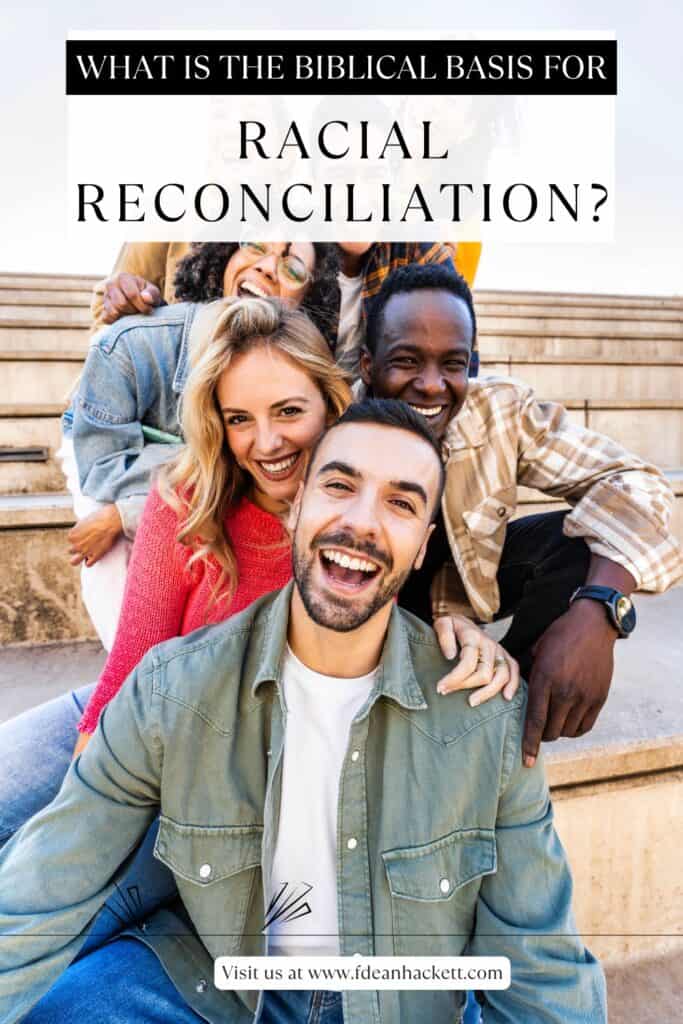What is the Biblical Basis for Racial Reconciliation?
I hope you love the products and resources I recommend here at Foundational. It is possible that I get a commission and collect income from the links on this page. Click here for more info.
March 1620, a Native American named Samoset came into the Plymouth colony.
He told them about another Native American named Squanto. These two men became significant in the life of the Plymouth colony.
They introduced the leaders of the colony to the leader of the Indians in that area, Massasoit.
William Bradford, leader of the Pilgrims, described the event in this way in his journal entitled The Plymouth Settlement.
After some time of entertainment, being dismissed with gifts, in a little while he returned with five more, and they brought back all the tools that had been stolen, and made way for the coming their great Sachem, called Massasoyt, who about four or five days after, came with the chief of his friends and other attendants and with Squanto. With him, after friendly entertainment and some gifts, they made peace which has now continue for twenty-four years:
William Bradford, Bradford’s History of the Plymouth Settlement, 1608-1650 Original Manuscript Entitled Of Plymouth Plantation, rendered into modern English by Harold Paget 1909 (San Antonio: Mantle Ministries 1988) 79-80
These were the terms:
- That neither he nor any of his, should injure or harm any of their people.
- That if any of his did any harm to any other theirs, he should send the offender, that they might punish him.
- That if anything were taken away from any of theirs, e should cause to be restored; and they should do the like to his.
- If any made unjust war against him, they would aid him; if any made war against them, he should aid them.
- He should send to his neighboring confederates, to certify, them of this, that they might not wrong them but might be likes comprised in the conditions of peace.
- That when their men came to them, they should leave their bows and arrows behind them.
Some historical records document this treaty went beyond the 24 years of Bradford’s records into 60 years of peace.
The peace pact was broken by another tribe of Native Americans that was either discontent or did not agree with the treaty being signed in the first place.
Professor Mookgo Solomon Kgatle of the University of South Africa, Department of Christian Spirituality, Church History, and Missiology, is a prolific writer.
In 2016 he authored, The influence of Azusa Street Revival in the early developments of the Apostolic Faith Mission of South Africa. He wrote in the introduction of that paper,
This article demonstrates the influence of Azusa Street Revival in the early developments of the Apostolic Faith Mission (AFM) of South Africa. This will be done by studying the Azusa Street Revival in context, the role played by William Sey- mour and the characteristics of the Revival. The article also studies the influence of Azusa Street Revival on the pioneers of Pentecostalism in South Africa, John G Lake and Thomas Hezmalhalch, African Pentecostal like Elias Letwaba and the Central Tabernacle Congregation. The purpose of this article is to demonstrate that the main impact of Azusa Street Revival in the early developments of the AFM of South Africa was its ability to unite people beyond their differences of race, gender, colour, age and others in a hostile political environment and Pentecostal experiences.
Mookgo Solomon Kgatle, PhD., The influence of Azusa Street Revival in the early developments of the Apostolic Faith Mission of South Africa (Missionalia, Vol. 44, No. 3, 2016)
He concluded the article with, “Therefore, the main impact of Azusa Street Revival in the early developments of the AFM of South Africa was its ability to unite people beyond their differences of race, gender, age, and color and Pentecostal experiences.”
The greatest capacity for racial reconciliation and the healing of our land is not political. It is not protesting, or riots, or Black Lives Matter. It is a Holy Spirit awakening.
What is the Old Testament view of color and race?
God created the first couple, Adam and Eve, in His own image.
They were the first parents of mankind. The entire human race has its origin and DNA from this first couple (Genesis 1:26-28).
Following the flood in which the entire population of the earth perished except three couples, Noah and his wife with his three sons and their wives, God repopulated the earth from these three families.
They were the sole survivors of the original parents and are now the parents of all human beings (Genesis 9:1-6).
It was God who scattered the people across the globe and initiated the various languages (Genesis 11:1-9).
The Holy Scriptures reveal God’s heart about racial prejudice in a very power way.
Miriam, the biological sister of Moses, was offended he had married a black woman of Ethiopia.
Miriam shared that bitterness with their brother, Aaron.
Out of the bitterness caused by the prejudice in their heart, Aaron and Miriam became critical and judgmental of Moses. They spoke about him in a demeaning way as a leader and they claimed equal status and equal authority.
God dealt with their racial prejudice severely (Numbers 12:1-16).
What is the New Testament view of color and race?
The Apostle Paul was in Athens on his second missionary journey when he was invited by some the philosophers to speak at the Areopagus.
In his address to these humanists the Apostle pointed out among the many deities of the Athenians on display was an altar “to the unknown god.”
He explained, the God for which they were searching was Almighty God, “who made the world and everything in it, since He is Lord of heaven and earth, does not dwell in temples made with hands.”
The Apostle then made this profound statement:
“And He has made from one blood every nation of men to dwell on all the face of the earth, and has determined their preappointed times and the boundaries of their dwellings…” (Acts 17:22-28).
The Apostle was referencing the Old Testament narrative.
All of mankind are of the same blood because we are of the same parentage.
Every human being, regardless of color or race, stands equal in worth and value in the sight of God.
“For you are all sons of God through faith in Christ Jesus. For as many of you as were baptized into Christ have put on Christ. There is neither Jew nor Greek, there is neither slave nor free, there is neither male nor female; for you are all one in Christ Jesus” (Galatians 3:26-28; Colossians 3:9-11; Revelation 5:9-10).
What is the Biblical conclusion?
Every human being has the same original parents in Adam and Eve and through Noah and his family.
We are all related.
God has your parentage, your skin color, and your nationality written in His book from the foundation of the world (Psalm 139:13-17).
The Holy Scriptures have the only basis for reconciliation.
All men and woman are sinners from birth. Stereotypes and racial profiling have their origin in the sinful heart of mankind.
Bigotry is a sin that fosters from bitterness in the heart of a man or woman.
We must not be blind to the sinfulness of racial prejudice and to the politicizing of it. Only the redemptive work of Jesus Christ can transform a sinful heart.
The Apostle Paul wrote in 2 Corinthians 5:17-2,
“Therefore, if anyone is in Christ, he is a new creation; old things have passed away; behold, all things have become new. Now all things are of God, who has reconciled us to Himself through Jesus Christ, and has given us the ministry of reconciliation, that is, that God was in Christ reconciling the world to Himself, not imputing their trespasses to them, and has committed to us the word of reconciliation.” (NKJV).
The ministry of reconciliation has been imparted to every disciple of Jesus Christ when they are born again.
The Holy Spirit deposits in their heart the word of reconciliation.
Based upon what foundation?
The creation of a new person by the renewing and regeneration of the Holy Spirit (Titus 3:5) in which they are given a new heart that is made in the righteousness of Jesus Christ (2Corinthians 5:21).
Bigotry and racial prejudice have no place in a righteous heart. Indeed, the righteous heart is an instrument of God for healing and reconciliation.
The born again child of God must choose to love every person and see every person as family, regardless of color.
We are not color blind.
We see color and acknowledge the differences and the differences in the culture of each color.
We choose to honor, respect, value and celebrate our differences.
We believe the best about every person.
We acknowledge we are all family because we have the same Creator, the same Heavenly Father, and the same Redeemer.
Read More:
A Biblical Answer to Black Lives Matter







